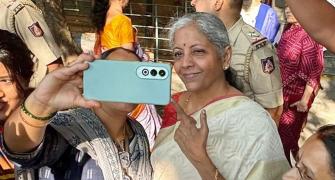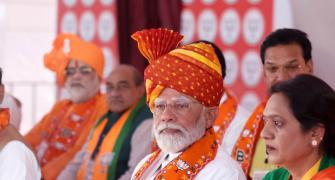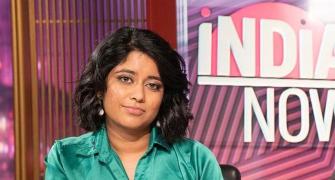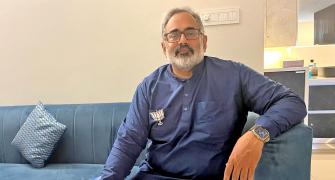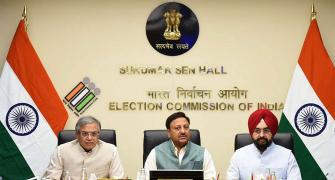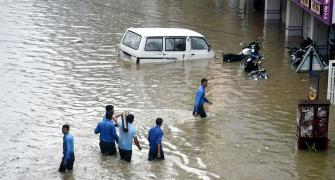"Matdaan saras chhe" said a text message sent by Bharatiya Janata Party (BJP) candidate for the Mumbai North East constituency, Kirit Somaiya, to his supporters and friends on Thursday noon.
This meant the efforts of the vast subterranean election machinery of any political party whose mettle is called to test in an election - in this case, the BJP's - had been successful in rousting their voters, getting them out of the house, into the polling booths to press the button that makes a "ping" sound (made famous by Rashtriya Janata Dal chief Lalu Prasad who made the sound and the graphic button-pressing gesture a part of his voter education programme).
The politics of turnout is a central part of any general election. For the 372 Lok Sabha seats that have gone to the polls so far, the average turnout has been 57.5 per cent. The overall average turnout figure was 57 per cent in 2004.
From this number hangs a tale. While in most crucial states, the polling was only around 50 per cent, in Andhra Pradesh it crossed 65 per cent in each phase. For the two phases together, the polling in the state was 72.5 per cent, far above the national average.
While the poll percentage was 69.40 per cent in the first phase, it was 75.5 per cent in the second, the highest in the history of Andhra Pradesh. Two Lok Sabha segments in West Godavari, from where film star-turned-politician Chiranjeevi hails, recorded the highest poll percentage ever, of 84 per cent.
It was this kind of skewed turnout that prompted senior BJP leader LK Advani to observe in Gandhinagar on Thursday after casting his vote, that elections to the Lok Sabha needed to be held on a fixed day in February along the lines of the American system because the timing of the election affected the voters' turnout.
Poll managers in both the major national parties, the BJP and the Congress, have their own understanding about what a turnout represents. As her mother and brother's election in Uttar Pradesh drew near, all that Priyanka Vadra, campaigning on behalf of her family in Rae Bareli and Amethi, harped on in her election speeches was: "Please ensure you go out and vote because we have to ensure the margin of victory increases".
The same point was made repeatedly by Sushma Swaraj of the BJP who won from Vidisha in Madhya Pradesh last time without even fighting it because her Congress opponent was rejected on technical grounds. "Don't treat this as a closed chapter. Please get people to come out and cast their ballot because it is the margin that is important," she told party workers in her constituency.
The more the voters from a party come out to vote, the better the chances of that candidate winning, is obvious. But manipulation of turnout is known to be crucial, especially in seats where there is a neck and neck fight. For instance, in the Baroda constituency of Gujarat, in 2004, Jayaben Thakkar of the BJP polled 48.4 per cent of the vote while
Satyajeet Gaekwad of the Baroda royal family polled 47.4 per cent.
In absolute terms, the margin was around 6,000 votes. Possibly worried that the Congress was snapping at its heels, the BJP changed its candidate and replaced Thakkar with Balkrishna (Balubhai) Shukla, the current Mayor of Baroda. If the Congress can inject in its cadres just a little bit more enthusiasm in ensuring a turnout of known Congress supporters, the BJP could lose this seat.
But how do you ensure a turnout ? What parties sometimes do is make sure the turnout is low - for the other guy. In the eight Srinagar seats for the Jammu and Kashmir assembly election that went to the polls on 24 December last year, National Conference workers went out and told party sympathizers to complete voting by about 11 am. In an area where cold weather permits voters to get out of the house for the polls only in the afternoon, NC workers grumbled but voted in the morning.
At around mid-day, rumours that militant groups had attacked someone somewhere - later proved it was only a rumour - ensured no one ventured out of the house to cast their ballot. The candidates of the People's Democratic Party (PDP) led by Abdullah's arch rival, Mufti Mohammad Sayeed, lost the election - the reason - PDP supporters just stayed at home.
In the first two hours of the poll alone - from 7 am to 9 am - the average voting was 10 to 11 per cent. The total turnout percentage for these seats was 21. In the ongoing Lok Sabha elections so far, in the first phase (16 April), Lakshadweep recorded the highest voter turnout, of 86 per cent, while Bihar recorded the lowest turnout of 46 per cent. Maharashtra, with 54 per cent, Chhattisgarh (51-54 per cent) and Jharkhand, with 50 per cent, were among the other states that recorded more than 50 per cent voter turnout
In the second phase (23 April) voting turnout ranged from 44 per cent in Bihar to a high of 80 per cent in Tripura. Uttar Pradesh (44), Madhya Pradesh (45), Jammu and Kashmir (46), Jharkhand (47), Orissa (55), Goa 55), Karnataka (55) and Maharashtra (56) saw respectable but not high turnout.
Which party's voters stayed at home and who came out to vote ? Hard to say but a rule of thumb is: cadre-based parties perform better in low-turnout elections. This theory will be put to test on May 16, the day of the counting.


